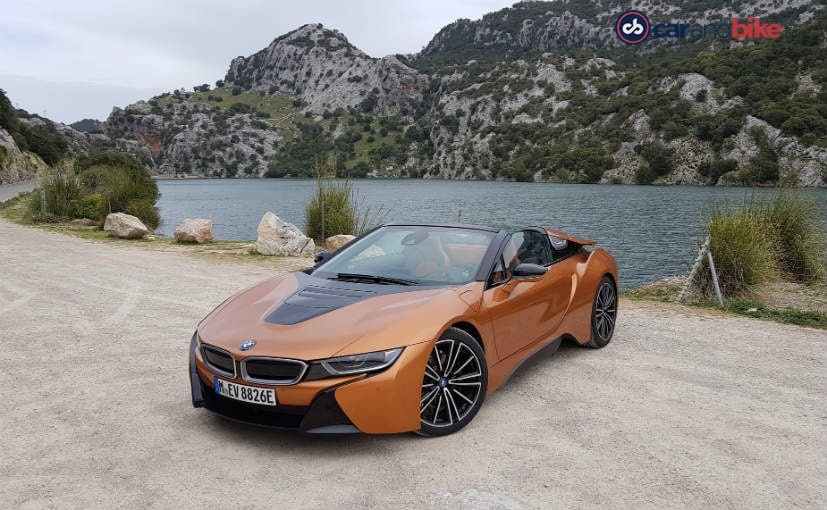
Sun, cool mountain-like-air, and gorgeous views of the Mediterranean – not the combination you find everywhere, and so Mallorca was the perfect setting to test the new BMW i8 Roadster. Any open-top needs that intoxicating combination to work. And so even though we arrived to the line-up of cars under a very cloudy sky that threatened imminent rain, I was still excited to fold down the roof and get going. The BMW i8 has already been hailed for it extremely futuristic, cutting edge design and technology. And even when a Spyder concept was shown, the company had no intention of building one as it was seen as being just too expensive to develop. I know you probably have a hard time believing this – just like I did – that when the first i8 was created there was no plan or intention to also subsequently do a convertible version of that coupe. But now I can believe it, as I have been taken through the work carried out to create this open-top version. And how costs were kept in check to make the project feasible. So think of the i8 Roadster as a new model, rather than a new bodystyle or variant offering, and you won’t be wrong says BMWi. The new Roadster looks every bit as sexy as the coupe, if anything it’s sexier. And my test car proved that amply – not only as it dressed in the new E-Copper metallic paintwork, but even its license plate told the world what it was – M EV 8826E. Electric vehicle (well hybrid anyway) and sexy! As coincidences go, that’s a good one!
Also Read: BMW i8 Review: World’s Most Futuristic Hybrid Sportscar
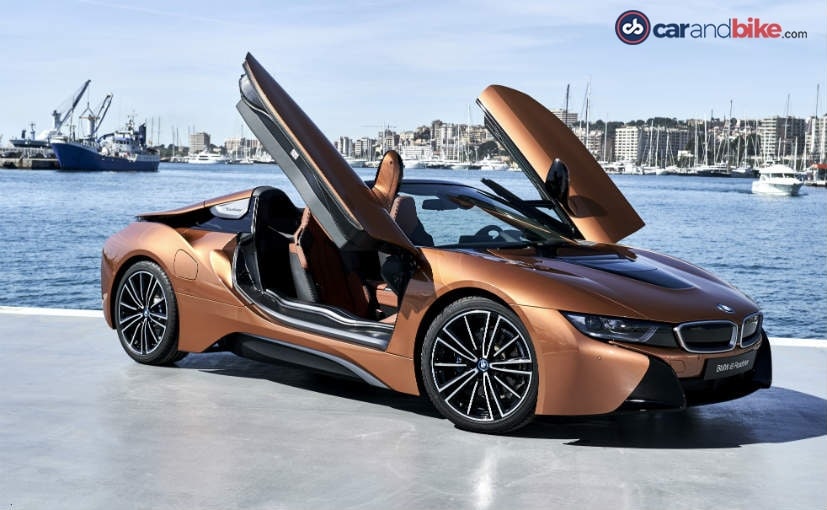
(The i8’s cool doors are retained on the Roadster, but are now frameless)
The Roadster was always meant to provide all the things any convertible does – the wind in your hair and the sun warming your spirits, while enjoying the exhilaration of ample performance capability. Let’s not lose sight of the fact that behind all the talk of sustainability, efficiency and carbon-fibre the i8 was always meant to be a sportscar. So the i8 Roadster also had to be one. And so challenge number one as always was how to achieve the stiffness, aerodynamics and acceptable weight increases that any convertible throws up. The engineering team began in a rather surprising way. They drove in a production i8, and sawed off its roof. Sounds rudimentary, but they wanted to test that car to see what all they needed to address, since the i8 isn’t a ‘normal’ car in the first place. And they found that the aluminium chassis and carbon fibre shell combination maintained a surprising amount of rigidity and stability even with the roof gone. And with the rear seats taken out too (since the roadster is a classic two-seater) the roofline of the folding-top could be angled sharply downwards, giving the i8 Roadster a much racier silhouette than its roofed sibling. Of course the car still has the scissor doors that go up, but they’re now frameless. This took a lot of work as well says BMW, but the result makes for a stunning look.
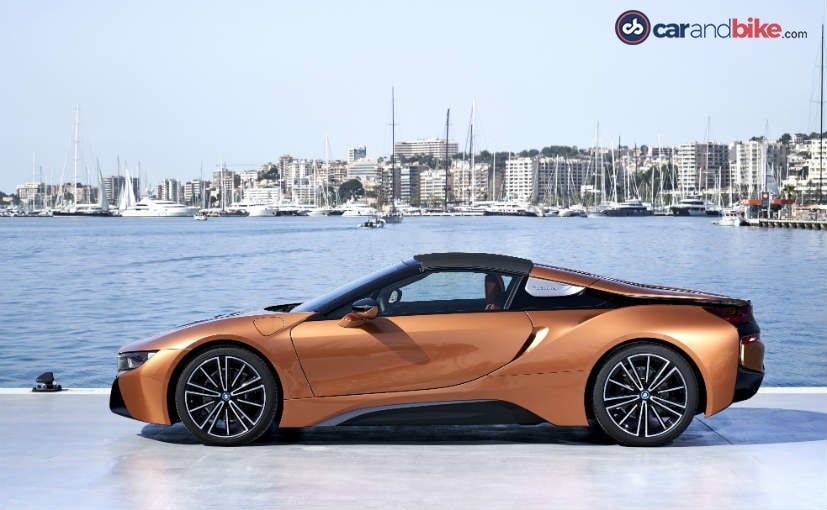
(The BMW i8 Roadster’s roofline with the top up is much sharper than the roof on the coupe)
The roof is made of a special fabric but is supported by an entire panel that sits below the cloth, giving the roof structure. That panel and frame are also made with carbon-fibre – a first. Strengthening the A-pillar to support that structure meant widening it. To reduce further weight the car’s 20″ alloys use a lighter material, shaving a kilogram of each wheel. It also uses 3D printed aluminium alloy parts in the folding mechanism. This helps achieve some weight loss too, but more significantly allows flexibility through a shape no forged or machined part could have been made in. Using a 3D printed part in a series production car is another first for the i8 Roadster. And so overall the Roadster is just 60 kgs heavier than the coupe, which is rather remarkable. The air vent in the middle of the hood that let out the hot air from the electric motor housing had to be shut. This is because that hot air was finding its way over the windscreen into the open cabin. Instead the air that comes in from the car’s mouth (just as in the coupe) is now let out through vents in the front wheel arches. But in design terms the hood still looks like it has a functional vent.

(A low-slung profile, typical of a sportscar, the BMW i8 Roadster has terrific road presence)
Okay so now you know how the car was designed and built, now let me tell you how it drives. The fun factor is very intact with the car, as it’s the incredible stiffness and therefore impeccable handling that the coupe had already exhibited. The car responds in a sportscar like fashion, and you can’t help but constantly keep the fact that it is a plug-in hybrid at the back of your mind. Perhaps this allows you to appreciate the performance more – I will admit that. And that’s because its credentials – though impressive for said plug-in hybrid – don’t necessarily match up to a V12 or V10 monster. Still the i8 Roadster will do 0-100 kmph in 4.6 seconds. It has an electronically-limited top speed of 250 kmph. And the car will now go up to 105 kmph whilst staying on electric power in hybrid mode (hit 106 kmph and the petrol engine will also kick in). But in pure eDrive mode – meaning pure electric – it can now go as fast as 120 kmph! The driving range in that pure electric mode is 53 kms – up 16 kms from the first coupé. Overall range stands at 440 kms, and can be extended to 600 kms with a larger 42 litre fuel tank – the regular tank is 30 litres. The battery pack is the same size, yet its cell capacity has been increased from 20 to 34 Ah, while energy capacity has gone up from 7.1 to 11.6 kWh. The electric motor’s output has also been enhanced and is up by 12 horses now to 141 bhp. The 3-cylinder 1.5 litre engine has also been reworked to now provide 228 bhp of power. Combined output is therefore 369 bhp. Torque from the electric motor housed in the front of the car goes directly to the front wheels it powers. Peak torque stands at 250 Nm, while the petrol engine powers the rear wheels and has 320 Nm of peak torque. This all-wheel drive system is what gave the coupé and now the Roadster its agility. The enhanced power, longer range powertrain is now standard on the coupé as well – a significant development for the i8 in general. The i8 family also gets a reworked suspension that is sportier, and gives you a more obvious feeling of being close to the ground, while satisfying the comfort parameters customers in this segment expect.

(The combined output of the electric and petrol motors is 369 bhp. The BMW i8 Roadster is an all-wheel drive, making it very agile)
So does all this translate to more fun while driving? That is an emphatic yes. The car propels itself forward with an impressive alacrity. The stiff dynamics keep you firmly planted and the steering is also up the task, staying precise. All of that gets even stiffer and more dynamic when you flick the gear lever to the left and engage Sport Mode. This will also change the instrument cluster display to a red theme, and immediately start the petrol engine, in case you had been coasting on electric power at the time of switching to Sport. The regular default drive mode is Comfort, and you can also opt for Eco Pro – just like other BMWs of course. In Eco Pro I found the steering feel lost in between trying to be stiff & engaging and pliant & comfortable. The other big negative for me is the extra thickness in that A-Pillar. It creates quite an obstruction – and on mountain roads as we climbed out of Calvia towards the north of the island – it was a bit of a challenge to have to look around it from both sides. The great weather and onset of vacation season in Europe also meant several hundred cyclists – individual or in groups of 5, 10 or even 20 – who proved to be a challenging moving obstacle. The A-pillar situation wasn’t helping!
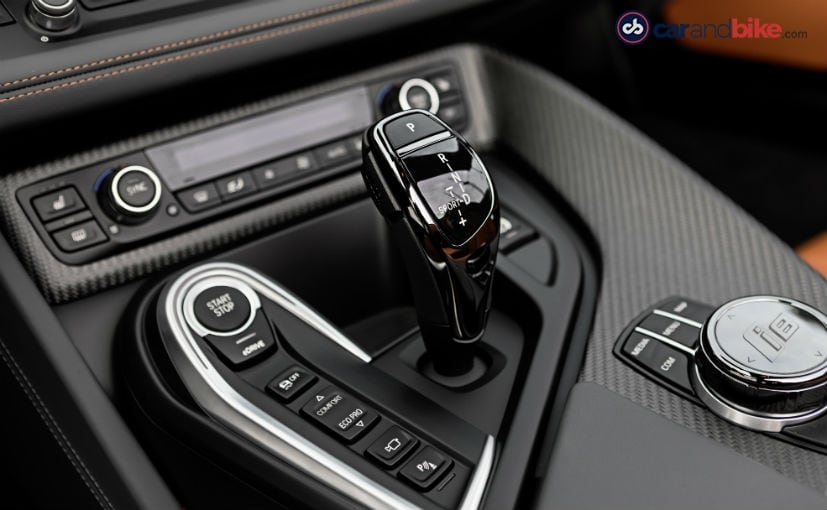
(The Comfort setting is the car’s default mode, but you can switch to Sport or Eco Pro. The car’s iDrive infotainment system is in its latest generation)
BMW engineers told me over dinner the previous night that a lot of work had been carried out to cut the wind noise that is bound to be a problem in any convertible. Noise-cancelling acoustics using special speakers in the cabin do help, but overall I found that wind noise is a bit of an Achilles heel for this car. Of course you also have special speakers inside the cabin, and outside that enhance the small engine’s roar. And they are rather effective, with a rumbly and satisfying growl emanating from the 3-pot motor. Enough to make me happy that I was driving a sportscar – and just like coupé had. But the twist is those speakers enhance or reduce that sound in the cabin, based on whether the roof is open or not! And here’s the kicker – they even regulate that volume as you fold the roof – while opening or closing. All this is to ensure you hear the same level of engine symphony, no matter the situation with the roof. Impressive!
The car sounds its snorty, roaring best in Sport Mode naturally, and that’s best displayed on the highway where you can indulge in fast overtaking manoeuvres and high-speed cruising. On the twisty mountain roads, it was a tad muted for my liking, even though the car did everything I wanted, taking tight corners with finesse and accelerating out of them with ease. And what’s astonishing is the level of performance it maintains even in eDrive mode. The weird whine of the electric mode can get a tad annoying, but the sheer performance BMW has been able to achieve on pure electric mode is rather impressive and fun. Everywhere I went heads turned, and many people wanted to take pictures, and asked me about the car. That half thought I owned the car, while the other half assumed I worked for BMW – was rather amusing! One particularly ambitious gentleman came to a stop next to me on his bicycle, and offered to exchange out rides! When I refused, he held up his cycle in both hands said – it’s made from carbon-fibre. I said – so is the car, but still, no!
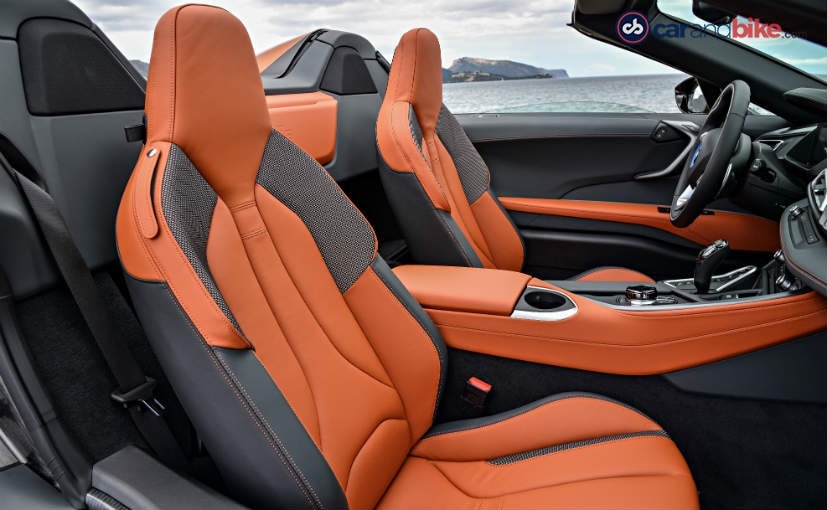
(The BMW i8 Roadster’s cabin has deeper, more comfortable seats than on the coupe)
The i8 Roadster’s cabin is sumptuous, well designed and crafted. The use of leather and carbon-fibre has been cleverly and intentionally directed to enhance the sportscar feel. The test car with me had leather in the same E-Copper like tone to complement the exterior. But I felt it looked even more striking on the grey cars that some of the others had – as the contrast really stood out. The car’s central console houses the screen with the new iDrive with its touch pad topped dial. A flip top binnacle between the seats has USB connectivity ports and also the button to fold the roof up or down. That process takes 15 seconds by the way, and can be operated while moving up to speeds of 50 kmph. Behind the front seats is a surprise – you get extra storage space – 90 litres of it – that can house a carry-on suitcase or your laptop/hand bag. The space also has foldable separators so that you can put smaller items and they won’t shift around on a sporty drive. The extra luggage space come courtesy a slimmer than expected folding roof mechanism – thanks to those 3D-printed parts I mentioned earlier. Of course there’s some space in the ‘boot’ just behind the engine – which can also house some small luggage or shopping. The car’s smart key lets you check on its location, battery and fuel levels, and also fold up or down the roof and windows remotely. The Lithium-ion battery takes under 2 hours for an 80 per cent charge and just under 3 for a 100 percent charge. That’s using a fast charger, and so a domestic outlet will charge the car to full in 4.5 hours. There is regenerative on-board charging too of course that helps enhance battery power while on the move. The i8 Roadster claimed mileage in the EU test cycle is 50 kmpl.

(Extra storage on the Roadster since there are no rear seats. 90 litres of space where you can fit in even a cabin bag)
Expect the i8 Roadster to be launched in India later this year. BMW had made that intent know when it showed the car at the 2018 Auto Expo in Delhi this February. Expect prices to stay well above ₹ 3 Crore when it launches.
[“source=auto.ndtv”]